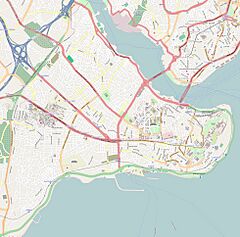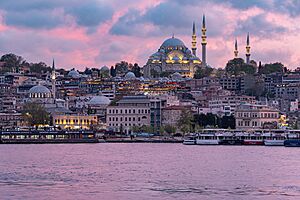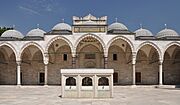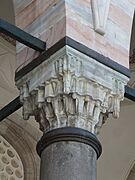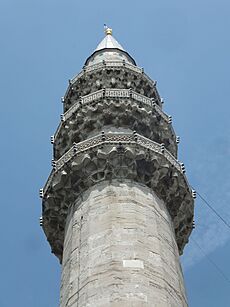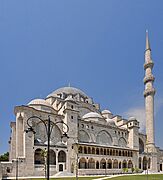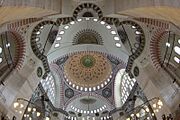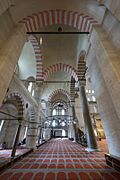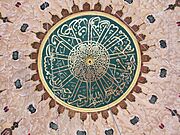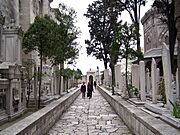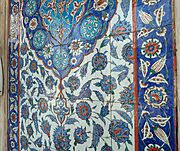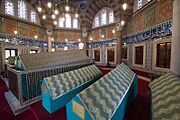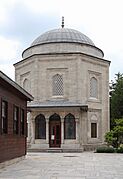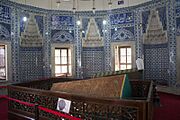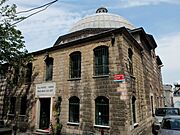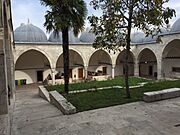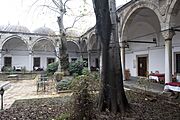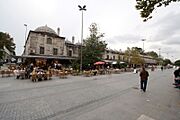Süleymaniye Mosque facts for kids
Quick facts for kids Süleymaniye Mosque |
|
|---|---|
|
Süleymaniye Camii
|
|
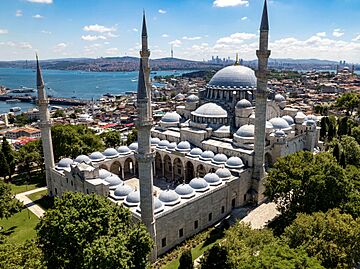 |
|
| Religion | |
| Affiliation | Islam |
| Location | |
| Location | Istanbul, Turkey |
| Architecture | |
| Architect(s) | Mimar Sinan |
| Architectural type | Mosque |
| Architectural style | Ottoman architecture (Classical) |
| Groundbreaking | 1550 |
| Completed | 1557 |
| Specifications | |
| Height (max) | 53 m (174 ft) |
| Dome dia. (inner) | 26 m (85 ft) |
| Minaret(s) | 4 |
| Minaret height | 76 m (249 ft) |
| UNESCO World Heritage Site | |
| Part of | Historic Areas of Istanbul |
| Criteria | Cultural: i, ii, iii, iv |
| Inscription | 1985 (9th Session) |
The Süleymaniye Mosque (pronounced soo-lay-mah-NEE-yeh Jah-mee) is a famous Ottoman imperial mosque in Istanbul, Turkey. It sits on one of Istanbul's seven hills, offering amazing views of the city.
This grand mosque was ordered by Suleiman the Magnificent, a powerful Ottoman ruler, and designed by the brilliant architect Mimar Sinan. Construction started in 1550 and finished in 1557.
The Süleymaniye Mosque is a true masterpiece of Ottoman architecture. Many consider it one of Mimar Sinan's greatest works. It is also the largest mosque from the Ottoman Empire era in Istanbul.
Like other big Ottoman mosques, it's part of a larger complex called a külliye. This complex included schools, a public kitchen, and a hospital. Behind the mosque, you can find the tombs of Suleiman the Magnificent and his wife, Hurrem Sultan.
The mosque and its surrounding area are part of the UNESCO World Heritage Site "Historic Areas of Istanbul". This means it's a very important place protected for its cultural value.
Contents
History
Building a Grand Mosque
Sultan Suleiman the Magnificent wanted a mosque that would be grander than any built before. He chose Mimar Sinan, his chief architect, for this huge project. Suleiman wanted the mosque to show how powerful and important the Ottoman Empire was.
The mosque was also a way for Suleiman to show his strong belief in Islam. The complex included many schools (called madrasas) that taught Islamic law and ideas. This helped strengthen the sultan's authority.
Suleiman even saw himself as a "second Solomon," like the wise king from ancient times. He wanted his mosque to be as impressive as the famous Hagia Sophia, a huge church in Istanbul that had been turned into a mosque.
How it was Built
The mosque was built on the site of an old palace. Construction began in 1550 and was mostly finished by 1557. However, some parts of the complex, like the schools and Suleiman's wife's tomb, were completed a few years later.
To build such a massive structure, workers gathered marble and other stones from different places. Some huge stone columns were even taken from the ancient Hippodrome of Constantinople.
Repairs and Restorations
Over the centuries, the Süleymaniye Mosque faced some challenges.
- In 1660, a big fire damaged the mosque. Sultan Mehmed IV helped restore it.
- An earthquake in 1766 caused part of the main dome to collapse.
- During World War I, the mosque's courtyard was used to store weapons. When some ammunition caught fire, the mosque was damaged again.
The mosque has been carefully restored many times. A major restoration happened in 1956. Between 1961 and 1967, the prayer hall was restored, revealing some of Sinan's original designs.
More recently, between 2007 and 2010, the mosque underwent its most thorough modern restoration. Experts worked to preserve the original materials and decorations. They carefully cleaned stone surfaces and replaced damaged parts. This work helped bring back the mosque's 16th-century beauty.
Architecture
The Courtyard
The mosque has a beautiful front courtyard with a fountain in the middle. The main entrance gate is very grand, with detailed carvings. Above the entrance, there's an inscription of the shahada, which is the Islamic declaration of faith.
The courtyard is huge, about 47 by 57 meters. It has a covered walkway (a colonnaded peristyle) with tall columns made of marble, granite, and a special stone called porphyry. These columns have unique "stalactite" carvings at the top.
Around the courtyard, you'll see water taps. These were used for ablutions, which is the washing ritual Muslims perform before prayer. The fountain in the center of the courtyard is mostly for decoration.
Tall Minarets
The mosque has four tall minarets, one at each corner of the courtyard. The two taller minarets have three balconies each, reaching about 76 meters high. These balconies have beautiful geometric patterns.
Having four minarets was special. In Ottoman times, only mosques built by a sultan could have this many. The ten balconies on the minarets are said to represent that Suleiman I was the 10th Ottoman sultan.
The Prayer Hall
Inside the Mosque
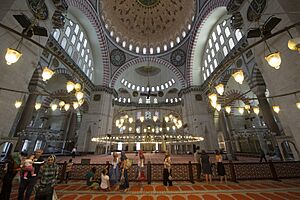
The inside of the mosque is a vast, open square space. It measures about 58.5 by 57.5 meters. The most striking feature is its huge central dome, which is 53 meters high and 26.5 meters wide.
The design of the dome is similar to the Hagia Sophia. The main dome is supported by two half-domes, one in front and one behind it. Smaller domes cover the side areas. Mimar Sinan was very clever in his design. He hid many of the large support pillars within the outer walls. This makes the inside feel more open and allows for more windows.
Beautiful Decorations
The mosque's interior decoration is elegant and not overly flashy. This was a choice by Sinan and Suleiman to follow Islamic traditions. A lot of the decoration comes from beautiful Islamic calligraphy, which is artistic writing. The calligraphy was done by Hasan Çelebi.
Most of the original painted decorations are gone due to past damages. The paintings you see in the central dome today were added during a 19th-century restoration. They are now considered part of the mosque's history.
The mihrab is a special niche in the wall that shows the direction of Mecca, which Muslims face during prayer. It's made of marble with lovely carvings. Next to it is the minbar, a pulpit where the imam (prayer leader) gives sermons.
You can also see beautiful Iznik tiles around the mihrab. These tiles have floral patterns in blue, turquoise, red, and black. The most colorful stained-glass windows are also on the qibla wall, near the mihrab. They show the names of God, the prophet Muhammad, and important early Islamic leaders.
The Süleymaniye Complex
Royal Tombs
Behind the mosque, there's a cemetery with the separate tombs (called türbe) of Suleiman the Magnificent and his wife, Hurrem Sultan.
Suleiman's tomb is a large octagonal building. It was finished around 1567, the year after he passed away. It has a covered walkway with 24 columns and beautiful Iznik tiles. Inside, you'll find not only Suleiman's tomb but also those of his daughter Mihrimah Sultan and two later sultans, Suleiman II and Ahmed II.
Hurrem Sultan's tomb is also octagonal and was completed in 1558. Its interior is decorated with lovely Iznik tiles.
Other Buildings in the Complex
The Süleymaniye Mosque was built as a külliye, which means it was a whole complex of buildings. These buildings served many needs for the community.
The original complex included:
- Four madrasas (religious schools)
- A small primary school
- A medical school and a hospital
- A public kitchen (imaret) that gave food to the poor
- A guesthouse (caravanserai)
- Public baths (hamam)
- A special school for learning hadith (sayings of Prophet Muhammad)
- Small shops that helped fund the complex.
Many of these buildings are still standing today. For example, the old public kitchen is now a restaurant. Just outside the complex, you can find the tomb of the great architect Mimar Sinan himself.
Burials
Many important people are buried at the Süleymaniye Mosque complex:
- Suleiman the Magnificent (1494–1566)
- Hürrem Sultan (1505–1558), Suleiman's wife
- Mihrimah Sultan (1522–1578), Suleiman and Hürrem's daughter
- Ahmed II (1642/43–1695), an Ottoman Sultan
- Suleiman II (1642–1691), an Ottoman Sultan
See also
- List of Friday mosques designed by Mimar Sinan
- List of mosques in Istanbul


